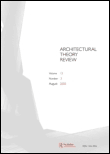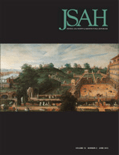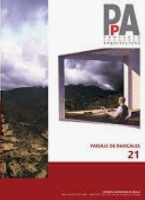
Fabrications-The Journal of the Society of Architectural Historians Australia and New Zealand
Scope & Guideline
Connecting Past and Present Through Architectural Insight
Introduction
Aims and Scopes
- Architectural History and Theory:
The journal focuses on the historical development of architecture, examining both local and global influences on architectural practices in Australia and New Zealand. - Cultural Heritage and Identity:
It explores the intersections of architecture with cultural heritage, identity, and memory, highlighting how architectural practices reflect and shape societal values. - Interdisciplinary Approaches:
Fabrications promotes interdisciplinary methodologies, integrating insights from history, sociology, anthropology, and cultural studies to enrich architectural discourse. - Contemporary Architectural Practices:
The journal addresses contemporary architectural practices, offering critiques and analyses of modern design and its socio-political implications. - Environmental and Contextual Considerations:
There is a strong emphasis on the relationship between architecture and its environment, considering both ecological sustainability and cultural context in architectural design.
Trending and Emerging
- Indigenous Architecture and Practices:
There is an increasing focus on Indigenous architectural practices and the entanglements of heritage, reflecting a broader societal recognition of Indigenous histories and contributions. - Political and Social Contexts of Architecture:
Recent articles emphasize the political dimensions of architecture, exploring how built environments interact with social justice, activism, and community identity. - Global Architectural Influences:
Emerging themes include the examination of global architectural influences and transnational exchanges, highlighting how architectural practices are informed by diverse cultural contexts. - Memory and Trauma in Architecture:
The journal is seeing a rise in discussions about memory, trauma, and how architecture serves as a medium for collective remembrance and cultural narratives. - Sustainability and Ecology in Design:
A notable trend is the integration of sustainability and ecological considerations in architectural discourse, addressing contemporary challenges in the built environment.
Declining or Waning
- Colonial Architecture:
While colonial architecture was previously a significant focus, recent publications indicate a waning interest in this theme, possibly as the field shifts towards more contemporary and local narratives. - Post-War Modernism:
The exploration of post-war modernist architecture appears to be less prevalent, as the journal increasingly prioritizes discussions surrounding contemporary practices and sustainability. - Technological Innovations in Architecture:
There has been a noticeable decrease in articles specifically addressing technological advancements in architecture, suggesting a shift away from a focus on innovation in favor of historical and cultural analyses.
Similar Journals

TRANSACTIONS OF THE ANCIENT MONUMENTS SOCIETY
Charting the Path of Ancient ArchitectureTRANSACTIONS OF THE ANCIENT MONUMENTS SOCIETY is a distinguished journal published by the Ancient Monuments Society in the United Kingdom, focusing on the rich interplay between architecture, conservation, and religious studies as they pertain to ancient monuments and heritage. With an ISSN of 0951-001X, this journal serves as an essential platform for researchers, professionals, and students interested in exploring methodologies, case studies, and theoretical perspectives that enhance our understanding of historical preservation and cultural significance. Although it has been classified in Q4 quartiles in prominent categories such as Architecture, Conservation, and Religious Studies, the journal plays a vital role in fostering scholarly dialogue in these areas. Access options and updates are available, making it easier for enthusiasts and experts alike to engage with ongoing discussions surrounding ancient monuments. Despite its discontinued coverage in Scopus, the journal remains an invaluable resource for those aiming to contribute to the conservation discourse and to understand the relevance of ancient sites in contemporary society.

Architectural Theory Review
Unveiling the Theoretical Dimensions of Architecture.Architectural Theory Review is a prestigious academic journal published by Routledge Journals, Taylor & Francis Ltd, located in the United Kingdom. With a focus on the interdisciplinary field of architecture and its theoretical underpinnings, this journal provides a critical platform for the exploration of contemporary architectural debates. Spanning from 2008 to 2016 and resuming from 2018 to 2024, Architectural Theory Review is categorized in the Q3 quartile of Visual Arts and Performing Arts, reflecting its significant contribution to the discourse within this area, as evidenced by its Scopus rank of #330 out of 667 journals. Although it does not offer an open access model, its rigorous peer-reviewed articles are valuable resources for researchers, professionals, and students committed to advancing their understanding of architectural theory. The journal's commitment to fostering insightful dialogue around architectural practices makes it an essential read for anyone in the field.

ABE Journal
Illuminating Contemporary Methodologies in Art HistoryABE Journal, ISSN 2275-6639 (E-ISSN 2275-6639), is an esteemed open-access publication emerging from the collaborative efforts of INVISU-CNRS-INHA and the Institut National d'Histoire de l'Art located in Paris, France. Since its inception in 2012, the journal has facilitated unrestricted access to groundbreaking research in the fields of art history and visual studies, making significant contributions to interdisciplinary scholarship. With a commitment to disseminating high-quality research, ABE Journal plays a crucial role in fostering dialogue among scholars, practitioners, and students alike. Its diverse range of articles underscores the innovation and evolution within the art historical discourse, as it seeks to engage an international audience eager to explore contemporary methodologies and practices. The journal not only enhances accessibility to vital research but also aims to elevate academic standards within its field, making it a vital resource for those seeking to stay at the forefront of art history and visual culture.

JOURNAL OF THE SOCIETY OF ARCHITECTURAL HISTORIANS
Championing Interdisciplinary Perspectives in ArchitectureJOURNAL OF THE SOCIETY OF ARCHITECTURAL HISTORIANS, published by the SOCIETY OF ARCHITECTURAL HISTORIANS, serves as a premier platform for the dissemination of scholarly research and critical discourse in the fields of architecture and architectural history. Established in 1970, this journal has undergone significant evolution, focusing on interdisciplinary studies that explore architectural heritage, theory, and practice. With a current impact factor that places it within the Q2 category in both History and Visual Arts and Performing Arts, as well as Q3 in Architecture, the journal maintains a robust reputation among academics and professionals alike. Although it operates under traditional access models, its essential role in fostering a deep understanding of architectural narratives and their socio-cultural contexts remains unparalleled. The journal also ranks favorably in Scopus, highlighting its importance in the arts and humanities, as well as engineering disciplines related to architecture. By bridging the gap between historical inquiry and contemporary architectural criticism, the JOURNAL OF THE SOCIETY OF ARCHITECTURAL HISTORIANS continues to be a vital resource for researchers, professionals, and students endeavoring to enrich their knowledge and contribute to this dynamic field.

Boletin Academico-Revista de Investigacion y Arquitectura Contemporanea
Advancing Knowledge in Contemporary Architectural Practices.Boletin Academico-Revista de Investigacion y Arquitectura Contemporanea is a distinguished journal published by SIELAE & UNIV CORUNA, Fac Filologia, focusing on the interconnectivity of contemporary architecture, cultural studies, and visual arts. With an E-ISSN of 2173-6723, this open-access publication serves as an essential resource for researchers, academics, and professionals eager to explore innovative perspectives and methodologies in these dynamic fields. Spanning a commendable period from 2016 to 2023, the journal demonstrates a strong academic footprint, ranked in the Q2 category for both Architecture and Cultural Studies, and holds a prestigious Q1 ranking in Visual Arts and Performing Arts. With Scopus rankings reflecting its growing influence—particularly in Visual Arts and Architecture—Boletin Academico delivers a platform that is not only academically rigorous but also culturally relevant, encouraging discourse that shapes the future of contemporary architectural and artistic practices. The journal’s commitment to open access further enhances its appeal, ensuring that groundbreaking research is readily available to an extensive audience.

Nexus Network Journal
Uniting Creativity and Calculation for a Brighter Future.Nexus Network Journal, published by KIM WILLIAMS BOOKS, stands as a premier interdisciplinary platform across the realms of architecture, visual arts, and mathematics. With origins tracing back to 2004 and converging until 2024, this journal has established itself in the academic landscape through its rigorous peer-reviewed articles and impactful scholarship. Holding impressive Scopus rankings—where it is placed in the 88th percentile for Visual Arts and Performing Arts and the 61st percentile for Architecture—it emphasizes innovative connections between these disciplines. Although it operates outside the open access paradigm, it maintains a strong commitment to disseminating knowledge, reflecting its distinguished Q1 status in Architecture and Visual Arts and Performing Arts as of 2023. Researchers, professionals, and students alike will find Nexus Network Journal to be an essential resource for advancing their understanding and fostering dialogue in the intricate relationships between architectural theory, artistic practice, and mathematical thought.

Constelaciones
Cultivating collaboration for transformative research.Constelaciones is a respected journal published by the FUNDACION UNIV SAN PABLO CEU, which serves as a vital platform for scholars and practitioners in the dynamic fields of cultural studies, social sciences, and humanities. With its ISSN 2340-177X and E-ISSN 2531-1360, this journal facilitates open dialogues on contemporary issues, featuring rigorous academic articles that contribute to theoretical frameworks and practical applications. The journal aims to foster interdisciplinary research and collaboration, making it an essential resource for researchers, professionals, and students. While detailed metrics such as impact factor and HIndex are yet to be established, the rich content and diverse scope signal the journal's commitment to advancing knowledge and enriching the academic community. Located in Alcorcón, Madrid, Spain, Constelaciones welcomes submissions that align with its mission of exploring innovative perspectives and emergent trends within its designated fields.

Proyecto Progreso Arquitectura
Transforming ideas into impactful architectural narratives.Proyecto Progreso Arquitectura, an esteemed academic journal published by UNIV SEVILLA, EDITORIAL, is dedicated to advancing the fields of Architecture, Arts and Humanities, History, Urban Studies, and Visual Arts. With an Open Access model since 2010, this journal facilitates the dissemination of innovative research and critical discourse among a global audience, fostering collaboration and insight within the academic community. Operating from Seville, Spain, the journal has successfully carved a niche in the architectural and design studies landscape, currently positioned in the Q3 category in Architecture and Urban Studies, and Q2 in History and Visual Arts as of 2023, demonstrating its growing impact and reputation. With an ISSN of 2171-6897 and an E-ISSN of 2173-1616, it also ranks commendably in Scopus across various disciplines, offering readers an invaluable resource for scholarly articles that contribute to the vibrant dialogues in architecture and its intersection with societal developments. The journal's approach not only encourages academic rigor but also embraces the practical implications of research, making it an essential read for researchers, practitioners, and students alike.

Cordis-Revista Eletronica de Historia Social da Cidade
Decoding the Social Fabric of Urban EnvironmentsCordis - Revista Eletrônica de História Social da Cidade is a distinguished academic journal published by the Pontifícia Universidade Católica de São Paulo, dedicated to exploring the intricate dynamics of urban social history. With an ISSN of 2176-4174, it serves as a vital platform for researchers, professionals, and students interested in the fields of social sciences, urban studies, and history. The journal aims to disseminate rigorous research and critical discourse on the social transformations within urban settings, focusing on Latin America, and especially Brazil. As an open access journal, Cordis strives to enhance the visibility of scholarly work and foster collaborative dialogues across disciplines. By providing high-quality content, it seeks to contribute to a deeper understanding of the historical context that shapes contemporary urban life, making it an essential resource for anyone engaged in the complex interplay between society and the urban environment.

Journal of Architecture and Planning -King Saud University
Fostering Dialogue on Design and Development.Journal of Architecture and Planning, published by King Saud University Press, serves as a critical platform for scholarly dialogue and innovation within the field of architecture and urban planning. This peer-reviewed journal, bearing the ISSN 1018-3604, aims to disseminate high-quality research that addresses contemporary challenges in architectural design, environmental sustainability, and urban development. Situated in Riyadh, Saudi Arabia, this journal not only highlights regional architectural practices but also fosters global discussions, making it an essential resource for researchers, professionals, and students alike. Although currently not open access, the journal is dedicated to providing extensive coverage of the latest findings and theoretical advancements in architecture and planning, paving the way for impactful contributions that can transform communities and enhance the built environment.